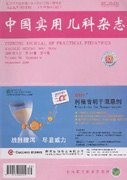|
Predictive value of noninvasive hemodynamic monitoring for fluid therapy responsiveness in children with septic shock
FAN Jiang-hua,KANG Xia-yan, ZHANG Xin-ping, et al
2021, 36(3):
205-210.
DOI: 10.19538/j.ek2021030611
Objective To explore the predictive value of noninvasive hemodynamic monitoring for fluid therapy volumetrical responsiveness in children with septic shock. Methods A total of 92 children with septic shock admitted to PICU Department of Hunan Children’s Hospital between February 2018 to March 2020 were enrolled. Hemodynamic parameters of all children were supervised by ICON noninvasive cardiac output monitoring(NICOM). The hemodynamic parameters included cardiac index(CI), stroke volume index(SVI) and systemic vascular resistance index(SVRI), etc. According to the △SVI, the patients were assigned into two groups,responsive group with a △SVI ≥10% and non-responsive group with a △SVI<10%. The changes in hemodynamic indexes before and after fluid therapy in the two groups were compared, and the predictive value of SVV, CI and SVI in fluid responsiveness was analyzed by receiver operating characteristic(ROC) curve. Results 1. There was no difference in age, gender, infection source, infection site PCIS or SOFA scores between the two groups(P>0.05). Both groups received mechanical ventilation, and the mechanical ventilation parameters were not statistically different(P>0.05); the incidence and mortality of pulmonary edema were significantly higher and the length of hospital stay and time on the machine were significantly longer in the non-responsive group than those in the responsive group after fluid therapy. 2. There were statistically significant differences in CI and SVI between the responsive group and the non-responsive group before treatment[CI (2.55±0.63) L/(min·m2) vs. (3.12±0.75) L/(min·m2); SVI (35.8±10.37) mL/(min·m2) vs.(40.5±6.3) mL/(min·m2). The CI, SVI and EF after fluid therapy were significantly higher after treatment than before fluid therapy, while HR, SVRI and SVV were significantly lower, which had statistically significant differences(P<0.05), but the increase in TFC was not significant(P>0.05). There was no obvious change in CI, SVV, SVI or SVRI before and after therapy(P>0.05) in the non-responsive group, but TFC was significantly higher after fluid therapy(P<0.05). 3. ROC curve analysis showed that SVV, SVI and CI had predictive value for volume responsiveness of liquid therapy. The area under the curve of SVV, SVI and CI was 0.836(95%CI 0.725~0.947), 0.778(95%CI 0.651~0.905) and 0.793(95%CI 0.663~0.922)(P<0.005), respectively. The sensitivity was 85.8% and the specificity was 80.3% when SVV≥13%, and they were 81.0% and 75.8% when SVI≤38 mL/(min·m2), and 78.5% and 79.2% when CI≤2.865 L/(min·m2). Conclusion NICOM can dynamically monitor the noninvasive hemodynamic indexes, and the SVV, SVI and CI can predict the fluid therapy volume responsiveness in children with septic shock. It is important in guiding early fluid resuscitation of septic shock and in optimizing fluid management and preload.
|

